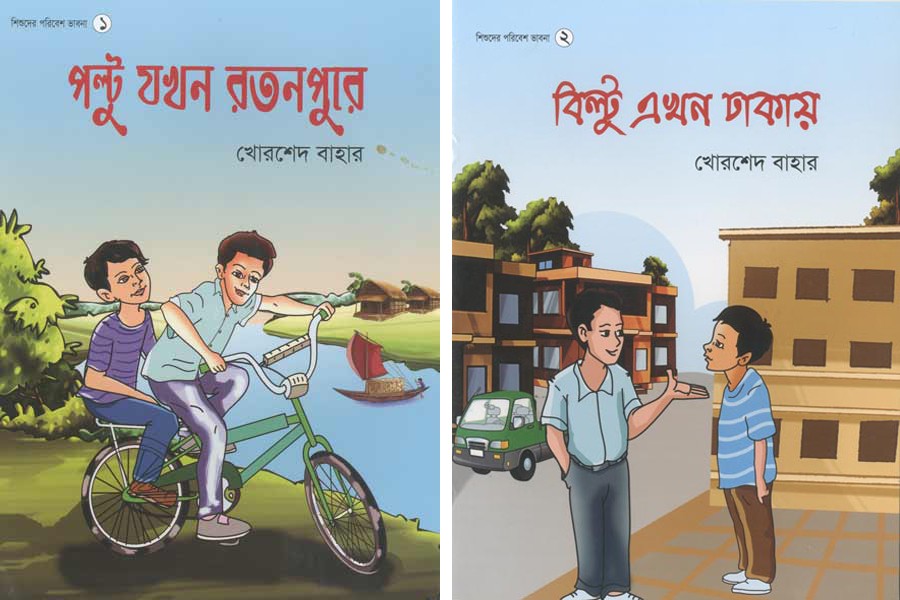 Poltu Jokhon Ratanpurey; Biltu Ekhon Dhakay (Two juvenile books) By Khorshed Bahar Cover and illustration: Palash Sarkar Published by Chitra Prokashoni, Dhaka. Taka 80/-
Poltu Jokhon Ratanpurey; Biltu Ekhon Dhakay (Two juvenile books) By Khorshed Bahar Cover and illustration: Palash Sarkar Published by Chitra Prokashoni, Dhaka. Taka 80/- Unlike many other major literatures, the one of Bangla has long been gifted with a rich genre comprising writings for children. However, there are exceptions found in English literature with Lewis Carroll and today's JK Rowling et al; and in Germany with the Grimm Brothers and others. Since the modern era in the early 20th century, scores of Bengalee poets and prose writers have continued to enrich this branch of literature. Rabindranath Tagore tops them all. Most of these writers, including Tagore, were mainstream authors; engagement in juvenile literature emerged as a delightful break. But dozens of authors with professional juvenile books appeared in the following decades. They included Upendrakishore Ray Chowdhury, Sukumar Ray, Satyajit Ray, Sukholota Rao, Shibram Chakraborty, Hemendrakumar Roy and many others. What is surprising is: The two celebrated Bengalee poets, Rabindranath Tagore and Kazi Nazrul Islam, have left a vast treasure of juvenile literature.
In the 20th century and the first two decades of the 21st, over a hundred children's writers appeared in Dhaka and Kolkata. In Bangladesh the pioneering figures include Roqunuzzaman Khan Dadabhai, Ahsan Habib, Habibur Rahman, Al Mahmud, Atowar Rahman, Ekhlas Uddin Ahmed, Sukumar Barua, Humayun Ahmed and many younger authors. Most of these writers focused on entertaining child readers with fanciful, jovial rhymes as well as gripping stories.
Against the backdrop of the need for creating awareness among children about environmental health these days, a completely new genre of juvenile literature is taking shape. It has already announced its strong presence among the child readers, with a few writers publishing stories and essays regularly. Two lavishly illustrated books by Khorshed Bahar with tales referring to environmental degradation and their preservation stand out among these publications. The books, written in Bangla, are 'Poltu Jokhon Ratanpurey' ('When Poltu Was in Ratanpur') and 'Biltu Ekhon Dhakay' ('Biltu Is Now in Dhaka'). A poet and already the author of a couple of juvenile fictions, Bahar is gifted with a unique flair for story-telling. The two slim books amply speak of his intimate experience of both rural and urban life in Bangladesh. Moreover, the tales of Biltu and Poltu, two cousins, enable the reader to feel the two boys' disillusionment and frustration at the declining environmental health in a village called Ratanpur. They have similar experiences in the largely polluted Dhaka city. Keen observation of life in the village and the city now and before by the author as well as his own worries about the declining environment has largely contributed to the two books becoming a vivid picture of the grim reality besetting the country.
Biltu, a school student, lives with his parents in a once-idyllic village. It has lately witnessed the setting up of a brick kiln beside crop fields. The village people are bearing the brunt of the kiln's atrocious presence. The unscrupulous owner and workers of the factory have already felled hundreds of trees to use those as logs in burning clay bricks. The black smoke and soot emitted by the brickfield has played havoc with the nearby croplands. Adding to the innocent villagers' woes, the water flowing through the only canal in the village has begun to get polluted by the effluents being drained from a dye factory on its bank. Poltu, the senior cousin of Biltu studying at a college in Dhaka, comes to the village on a holiday trip. He had little idea that an environmental nightmare was awaiting him at Ratanpur.
The first book about Poltu's experience of the collapsing rural environment narrates the story of the two cousins' disenchantment with the present state of life in the village. The second book takes the reader to Dhaka along with Biltu. He has developed lung infections from the smoke of the brick kiln. He, along with his father and an uncle, pays a visit to the city to avail treatment at hospital. The rest of the episode is another series of urban environmental nightmares. Beginning with inhaling second-hand tobacco smoke, to watching open dumpsters overflowing with household and other waste, city stuck in traffic gridlock to the shabby hospital premises, there is no dearth of nauseating experiences in Dhaka. On his first visit to the capital, Biltu gets bewildered. Poltu explains everything to his younger cousin including the role they should play in halting environmental degradation.
Khorshed Bahar seems highly conscious of the psychology of child readers. Being aware of it, he lays stress on story and narration. Thus without using the environmental jargons, he deftly touches upon the critical ecological hazards like the loss of biodiversity, air and water pollution, arsenic contamination etc. Owing to their catchy story-lines, the two books will not fail to prove appealing to young readers. Books belonging to this unique literary segment can greatly help build the country's future generations as citizens aware of their environmental responsibilities.
© 2024 - All Rights with The Financial Express
